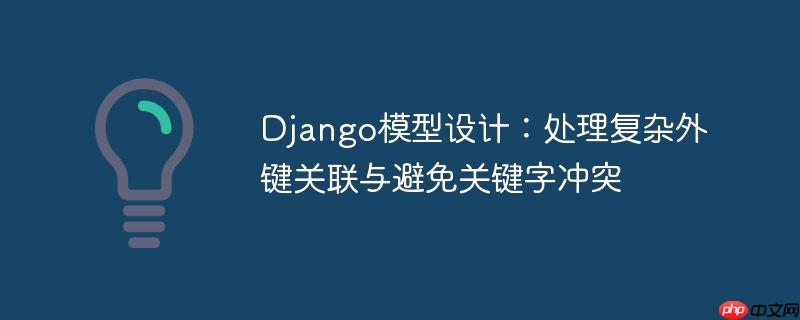
在django模型设计中,我们经常需要定义模型间的复杂关系。一个常见场景是,某个模型的外键字段(例如asset的subtipo)需要与其另一个外键字段(例如asset的type)所关联的模型(assettype)的多对多关系(subtipos)中的成员保持一致。以下是原始代码中导致问题的模型定义:
class SubAssetType(models.Model):
name = models.CharField(max_length=50)
slug = models.SlugField()
descripcion = models.TextField(null=True, blank=True)
class AssetType(models.Model):
name = models.CharField(max_length=50)
slug = models.SlugField()
descripcion = models.TextField(null=True, blank=True)
subtipos = models.ManyToManyField(SubAssetType, blank=True)
class Asset(models.Model):
# Atributos nominales
name = models.CharField(max_length=50)
slug = models.SlugField()
descripcion = models.TextField(null=True, blank=True)
# Atributos de valor
type = models.ForeignKey(AssetType, on_delete=models.CASCADE)
subtipo = models.ForeignKey(type.subtipos, on_delete=models.CASCADE)上述代码在运行时会抛出AttributeError: type object 'type' has no attribute 'subtipos'。这个错误由两方面原因造成:
要解决上述问题,我们需要进行两项关键修正:
避免使用Python的保留关键字或内置函数名作为模型字段名。将Asset模型中的type字段重命名为更具描述性且无冲突的名称,例如tipo或asset_type。
subtipo字段应该直接指向SubAssetType模型,因为它是一个外键,其值将是SubAssetType模型实例的主键。而“subtipo必须属于tipo所关联的AssetType的subtipos集合”这一逻辑,不应在ForeignKey定义中直接表达,因为它属于业务逻辑范畴,需要通过应用层面的验证来实现。
根据以上修正,Asset模型应重构如下:
class SubAssetType(models.Model):
name = models.CharField(max_length=50)
slug = models.SlugField()
descripcion = models.TextField(null=True, blank=True)
def __str__(self):
return self.name
class AssetType(models.Model):
name = models.CharField(max_length=50)
slug = models.SlugField()
descripcion = models.TextField(null=True, blank=True)
subtipos = models.ManyToManyField(SubAssetType, blank=True)
def __str__(self):
return self.name
class Asset(models.Model):
# Atributos nominales
name = models.CharField(max_length=50)
slug = models.SlugField()
descripcion = models.TextField(null=True, blank=True)
# Atributos de valor
# 将 'type' 重命名为 'tipo' 以避免关键字冲突
tipo = models.ForeignKey(AssetType, on_delete=models.CASCADE)
# subtipo 直接指向 SubAssetType 模型
subtipo = models.ForeignKey(SubAssetType, on_delete=models.CASCADE)
def __str__(self):
return self.name虽然数据库层面的ForeignKey定义无法直接表达“subtipo必须是tipo关联的AssetType的subtipos之一”这种复杂的业务约束,但我们可以在Django的应用层面(例如,在表单的clean方法或模型的clean方法中)实现这种验证逻辑。
以下是一个在Django表单中实现此验证的示例:
from django import forms
from .models import Asset, AssetType, SubAssetType
class AssetForm(forms.ModelForm):
class Meta:
model = Asset
fields = '__all__'
def clean(self):
cleaned_data = super().clean()
tipo = cleaned_data.get('tipo')
subtipo = cleaned_data.get('subtipo')
if tipo and subtipo:
# 检查选定的 subtipo 是否在选定的 tipo 的 subtipos 集合中
if not tipo.subtipos.filter(pk=subtipo.pk).exists():
raise forms.ValidationError(
"所选的子类型不属于该资产类型下的有效子类型集合。"
)
return cleaned_data
# 在视图中使用这个表单
# def create_asset(request):
# if request.method == 'POST':
# form = AssetForm(request.POST)
# if form.is_valid():
# form.save()
# return redirect('success_page')
# else:
# form = AssetForm()
# return render(request, 'asset_form.html', {'form': form})通过在表单的clean方法中添加自定义验证逻辑,我们可以在数据保存到数据库之前,确保Asset实例的subtipo确实是其tipo所关联的AssetType允许的子类型之一。这种方法将模型间的基本关系定义与业务规则验证分离,使模型结构更清晰,同时确保了数据完整性。
遵循这些原则,可以帮助您构建更健壮、更易于维护的Django应用程序。
以上就是Django模型设计:处理复杂外键关联与避免关键字冲突的详细内容,更多请关注php中文网其它相关文章!

每个人都需要一台速度更快、更稳定的 PC。随着时间的推移,垃圾文件、旧注册表数据和不必要的后台进程会占用资源并降低性能。幸运的是,许多工具可以让 Windows 保持平稳运行。

Copyright 2014-2025 https://www.php.cn/ All Rights Reserved | php.cn | 湘ICP备2023035733号